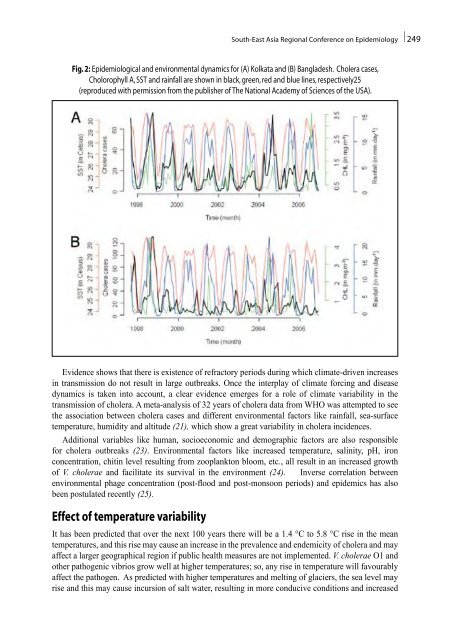South-East Asia Regional Conference on Epidemiology
South-East Asia Regional Conference on Epidemiology
South-East Asia Regional Conference on Epidemiology
Create successful ePaper yourself
Turn your PDF publications into a flip-book with our unique Google optimized e-Paper software.
<str<strong>on</strong>g>South</str<strong>on</strong>g>-<str<strong>on</strong>g>East</str<strong>on</strong>g> <str<strong>on</strong>g>Asia</str<strong>on</strong>g> <str<strong>on</strong>g>Regi<strong>on</strong>al</str<strong>on</strong>g> <str<strong>on</strong>g>C<strong>on</strong>ference</str<strong>on</strong>g> <strong>on</strong> <strong>Epidemiology</strong> | 249<br />
Fig. 2: Epidemiological and envir<strong>on</strong>mental dynamics for (A) Kolkata and (B) Bangladesh. Cholera cases,<br />
Cholorophyll A, SST and rainfall are shown in black, green, red and blue lines, respectively25<br />
(reproduced with permissi<strong>on</strong> from the publisher of The Nati<strong>on</strong>al Academy of Sciences of the USA).<br />
Evidence shows that there is existence of refractory periods during which climate-driven increases<br />
in transmissi<strong>on</strong> do not result in large outbreaks. Once the interplay of climate forcing and disease<br />
dynamics is taken into account, a clear evidence emerges for a role of climate variability in the<br />
transmissi<strong>on</strong> of cholera. A meta-analysis of 32 years of cholera data from WHO was attempted to see<br />
the associati<strong>on</strong> between cholera cases and different envir<strong>on</strong>mental factors like rainfall, sea-surface<br />
temperature, humidity and altitude (21), which show a great variability in cholera incidences.<br />
Additi<strong>on</strong>al variables like human, socioec<strong>on</strong>omic and demographic factors are also resp<strong>on</strong>sible<br />
for cholera outbreaks (23). Envir<strong>on</strong>mental factors like increased temperature, salinity, pH, ir<strong>on</strong><br />
c<strong>on</strong>centrati<strong>on</strong>, chitin level resulting from zooplankt<strong>on</strong> bloom, etc., all result in an increased growth<br />
of V. cholerae and facilitate its survival in the envir<strong>on</strong>ment (24). Inverse correlati<strong>on</strong> between<br />
envir<strong>on</strong>mental phage c<strong>on</strong>centrati<strong>on</strong> (post-flood and post-m<strong>on</strong>so<strong>on</strong> periods) and epidemics has also<br />
been postulated recently (25).<br />
Effect of temperature variability<br />
It has been predicted that over the next 100 years there will be a 1.4 °C to 5.8 °C rise in the mean<br />
temperatures, and this rise may cause an increase in the prevalence and endemicity of cholera and may<br />
affect a larger geographical regi<strong>on</strong> if public health measures are not implemented. V. cholerae O1 and<br />
other pathogenic vibrios grow well at higher temperatures; so, any rise in temperature will favourably<br />
affect the pathogen. As predicted with higher temperatures and melting of glaciers, the sea level may<br />
rise and this may cause incursi<strong>on</strong> of salt water, resulting in more c<strong>on</strong>ducive c<strong>on</strong>diti<strong>on</strong>s and increased









